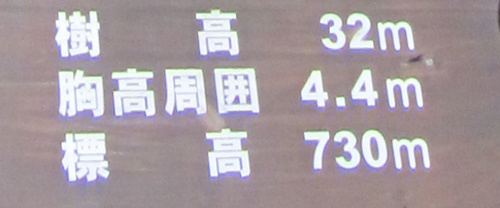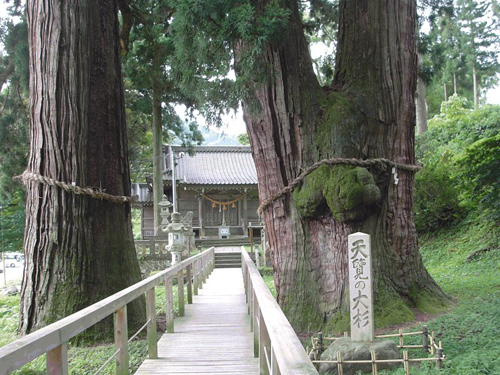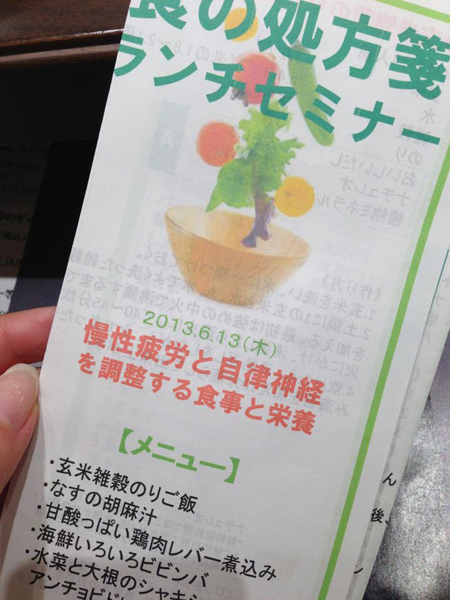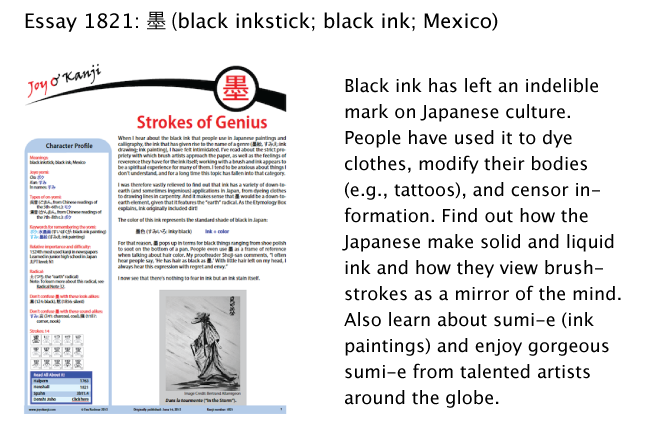When Confusion Rises to New Heights
Twice recently I have felt confused about Japanese. Well, I should probably inflate that number by an order of 10 or 100, just to account for all the puzzlement I experience in an average week. But I can remember only two episodes of note. Both had to do with height.
For my forthcoming essay on 杉 (すぎ: cedar), I examined a photo that gave the vitals on an enormous and ancient cedar on Yakushima, an island off of Kyushu:

Photo Credit: Anne Hill
I could figure out the first and last lines without too much trouble:
樹高 (じゅこう: height of the tree): 32m
胸高周囲 (きょうこうしゅうい: ??????): 4.4m
標高 (ひょうこう: altitude): 730m
But what did the second line mean? The characters 胸高周囲 break down as chest + height + circumference (last 2 kanji). The chest of a tree? I've heard of the "waist" of a willow, an idea I encountered in essay 1898 on 柳 (willow):
柳腰 (やなぎごし: waist of a willow) willow + waist
Where is the waist of a willow or of any tree?! Doesn’t a tree have as much of a waist as a snake?
I've also heard of the "crotch" of a tree:
木の叉 (きのまた: crotch of a tree) tree + crotch, fork in road
The second kanji is non-Joyo.
Clearly, trees abound in body parts. But do they also have chests?
As I continued to work on the cedar essay, I found this photo:

Photo Credit: Namazu-tron
Apparently shot by a Japanese photographer, it came with a concise Japanese caption and then this one in English: "Great sugi of Kayano, Cryptomeria japonica, on the right side, the height is 60 meters approx. and perimeter is 9.6 meters at height of human chest."
Height of human chest??? Oh, the human has the chest, not the tree! The previous sign must have referred to the tree circumference at a human's chest height. But which human? There could be quite a big range, given the vast differences in human heights. I won't quibble, though. I'm just happy to have cracked the code!
(Oh, it turns out that there is a set height for this measurement, after all: 1.3 meters. Well, that takes care of that!)
I felt confused about something else last weekend when a Japanese man sent me a brief message. He had contributed a terrific landscape photo to essay 1593 on 嵐 (storm), so I sent him the essay PDF. This is part of what he wrote in response:
作品に取り上げていただき有難うございます。
作品 (さくひん: work (e.g., composition)); 取り上げる (とりあげる: ??????);
有難うございます (ありがとうございます: thank you)
What did he mean by 取り上げる (とりあげる)? It has umpteen meanings, and none seemed to fit:
1. to pick up; to take up
2. to adopt; to accept; to listen to
3. to take away; to confiscate; to deprive; to disqualify
4. to deliver (a child)
I knew, at least, that I could rule out the last one.
Later that day I turned to Kensuke-san, my language partner, during our regularly scheduled Skype chat. He explained that 取り上げる simply meant "to adopt" in this case (i.e., Thank you for using my picture in your essay). And he explained at length that people occasionally use 取り上げる when someone has elevated the importance of an event (but not of an object) in a good way.
As he spoke about this, the following expression came to my mind:
針小棒大 (しんしょうぼうだい: exaggeration; making a mountain out of a molehill)
needle + small + pole + big
However, making a mountain out of a molehill is the opposite idea. The molehill should remain just a molehill. Inflating its importance is nothing but an exaggeration.
Although Japan abounds in mountains, this expression doesn't include 山 (mountain) but rather small needles (針) that turn into big poles (棒). Actually, that makes sense, too. This yojijukugo came from China, and if there's one thing China has a lot of (besides people), it's acupuncture needles.
It excites me to see this expression because I wrote about it long ago in a Kanji Curiosity blog. Such reunions always make me happy.
In fact, I had more such experiences this morning when I checked Facebook. A friend had attended a seminar on healthy eating and had posted this picture of the brochure:

Photo Credit: Kayoko Kurimoto
I was bleary-eyed when I spotted it, as I had just awakened, and although I needed to move on with my day, I somehow couldn't stop staring at this image. For me it was like a "word find" game because it contains four (!) terms that I've written about in Joy o' Kanji essays:
慢性 (まんせい: chronic), from essay 1837 on 慢 (arrogant; proud; boastful; sluggish; lazy)
玄米 (げんまい: unmilled rice; brown rice), from essay 1227 on 玄 (mysterious; occultness; blackness; profound)
胡麻 (ごま: sesame seed), from essay 1829 on 麻 (hemp, flax; to become numb)
甘酸っぱい (あまずっぱい: sweet and sour; bittersweet), from essay 1093 on 甘 (sweet; fragrant; tempting; indulgent)
It's hard for me to explain why it's such a thrill to see these "old friends" again in a real-world context. But they do feel like friends or maybe like former lovers! After all, I spent quite a bit of time with three of these words, and they became very familiar to me. On top of that, I find it deeply satisfying that, simply by focusing on a word and thinking about all that it entails, I can actually absorb it and know it when I see it! This thing I'm doing is working! I certainly hope it has the same effect on you.
Here's the full text of the brochure, along with all the definitions:
Green text at the top:
処方箋 (しょほうせん: prescription (medical))
ランチセミナー (lunch seminar)
Red text:
慢性疲労と自律神経を調整する食事と栄養
Meals and nutrition that adjusts (or heals) chronic fatigue and autonomic nerves (that are in bad condition)
慢性 (まんせい: chronic); 疲労 (ひろう: fatigue); 自律神経 (じりつしんけい: autonomic nerves); 調整 (ちょうせい: adjustment); 食事 (しょくじ: meal); 栄養 (えいよう: nutrition)
Black text:
• 玄米雑穀のりご飯
Unmilled rice containing various grains and seaweed
玄米 (げんまい: unmilled rice; brown rice); 雑穀 (ざっこく: (1) assorted grains; cereals; (2) millet); のり (海苔: dried sheets of seaweed, where 苔 is non-Joyo); ご飯 (ご はん: meal)
• なすの胡麻汁
Miso soup with (sliced) eggplant and (ground) sesame seeds in it
なす (eggplant); 胡麻汁 (ごまじる: miso soup with (usually ground) sesame seeds)
• 甘酸っぱい鶏肉レバー煮込み
Sweet-and-sour chicken liver stew
甘酸っぱい (あまずっぱい: sweet and sour); 鶏肉レバー (とりにくレバー: chicken liver);
煮込み (にこみ: stew; something simmered)
• 海鮮いろいろビビンバ
Bibimbab made of various types of fresh seafood
海鮮 (かいせん: fresh seafood); ビビンバ (bibimbab, a Korean rice dish)
• 水菜と大根のシャキシャキサラダ
Crispy salad containing mizuna and daikon
水菜 (みずな: mizuna; potherb mustard); 大根 (だいこん: daikon radish);
シャキシャキ (onomatopoeia for crunchy sounds); サラダ (salad)
Of course, we can't see how that last line ends, but my proofreader helped me out here by taking a very good guess.
Shifting to less edible items, I'm very excited to introduce the newest essay, which is on 墨 (ink). Weighing in at 22 pages, the essay is stuffed to the bursting point with eye-opening information and includes nine incredible pieces of black-ink artwork from artists from around the globe: Patricia Inés Gómez in Argentina, Mariusz Szmerdt in Poland, Bertrand Allamigeon in France, and Grégory Cortecero, also in France. To return to the earlier theme of heights, their art elevates the essay beyond measure—even beyond measurements of circumference! I'm grateful to each of them for allowing me to include such fabulous work.
Here's a preview of essay 1821 on 墨:

Have a great weekend!

Comments